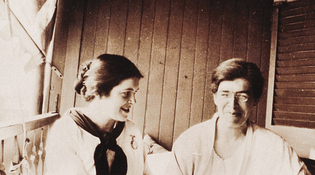 loading
loading
Old YaleDual-career coupleBetween the world wars, life partners Martha May Eliot and Ethel Collins Dunham taught at Yale’s medical school—and were pioneers in pediatrics. Judith Ann Schiff is chief research archivist at the Yale University Library.  Schlesinger Library, Radcliffe Institute, Harvard UniversityMartha May Eliot (left) and Ethel Collins Dunham, shown here in a 1915 snapshot, were two of the first three women on Yale’s medical school faculty. Between them, they helped introduce effective ways to prevent rickets; wrote the Social Security Act sections on maternal and child health; and instituted national standards for hospital care of newborns—among many other achievements. View full image“Some 1,500,000 war babies owe an expression of thanks—a gurgle, a cry, or a holler—to Martha May Eliot.” So said the Washington Post in 1948, in a salute to Eliot’s World War II leadership of the Emergency Maternity and Infant Care program. The program had provided maternal care for 1.5 million servicemen’s wives, so Eliot had literally helped that many babies. Yet Eliot (1891–1978)—and her domestic partner, Ethel Collins Dunham (1883–1969)—helped far more children than that. They were an extraordinary medical couple whose groundbreaking research, advocacy, and administrative achievements, over three decades at Yale and elsewhere, greatly improved public health care for children. Dunham and Eliot both enrolled in Bryn Mawr in 1910; there they met and formed a lifelong bond. In 1914, they entered medical school together at Johns Hopkins. They counted on internships at Johns Hopkins, but only Dunham was accepted; she was the pediatrics department’s first female intern, and the department was not ready for two women. Eliot went to Boston’s Peter Bent Brigham Hospital and completed her residency in St. Louis. The couple’s association with Yale began in 1919, when Dunham was appointed as the first woman house officer at the New Haven Hospital. Soon thereafter came a new opportunity. Post-war Yale was undergoing a reconstruction, and one critical requirement of a particularly generous grant to the medical school was that the school establish a full-time pediatrics department. Edwards A. Park, Class of 1900, was recruited from Johns Hopkins as pediatrics professor. He had taught Dunham and Eliot at Hopkins, and he appointed them both as instructors: in 1920, Ethel Dunham became the first woman on the medical school faculty, and in 1921 Martha Eliot joined her, along with Ruth Alline Guy (who would leave Yale in 1924). Once reunited at Yale, Dunham and Eliot lived together for the rest of their lives, except for temporary separations. During those separations they wrote to each other tenderly: “Dearest, it was hard to say goodbye and I shall miss you terribly,” “I miss you my darling.” Their partnership seems to have been accepted by their community, as such “Boston marriages”—women’s romantic partnerships—sometimes were. The women’s history scholar Lillian Faderman notes that Eliot often mentioned Dunham in her letters home. In 1920, from St. Louis, Eliot wrote her mother that she wanted “to find out what the future will bring forth not only for me but for Ethel too.” Their relationship does not seem to have impeded their careers. In 1924, Eliot was appointed director of the federal Children’s Bureau’s Division of Child and Maternal Health, working one week a month in Washington and maintaining her Yale appointment. Meanwhile, her landmark New Haven Rickets Study with Park led to the recommendation of cod-liver oil and sunshine as effective preventive measures to be administered by mothers. After her appointment as assistant chief of the Children’s Bureau in 1934, Eliot gave up her associate professorship at Yale but continued as a lecturer. She drafted the sections of the Social Security Act on maternal and child health. In 1947, she became the first woman elected president of the American Public Health Association. Dunham, for her part, was appointed chief of child development at the Children’s Bureau in 1935, and like Eliot relinquished her Yale associate professorship to become a lecturer. Once in Washington she instituted national standards for the hospital care of newborns and set up a program of home health-care visits. She published one of the first books on premature babies—Premature Infants: A Manual for Physicians—in 1948. Dunham and Eliot retired from Yale in 1950 and worked for the World Health Organization in Geneva from 1949 to 1951. That year, President Truman named Eliot chief of the Children’s Bureau and they returned to Washington. In 1956, Eliot became a professor of maternal and child health at Harvard. Dunham (in 1958) and Eliot (in 1967) were the first women to be awarded the John Howland Award—the American Pediatric Society’s highest honor.
The comment period has expired.
|
|